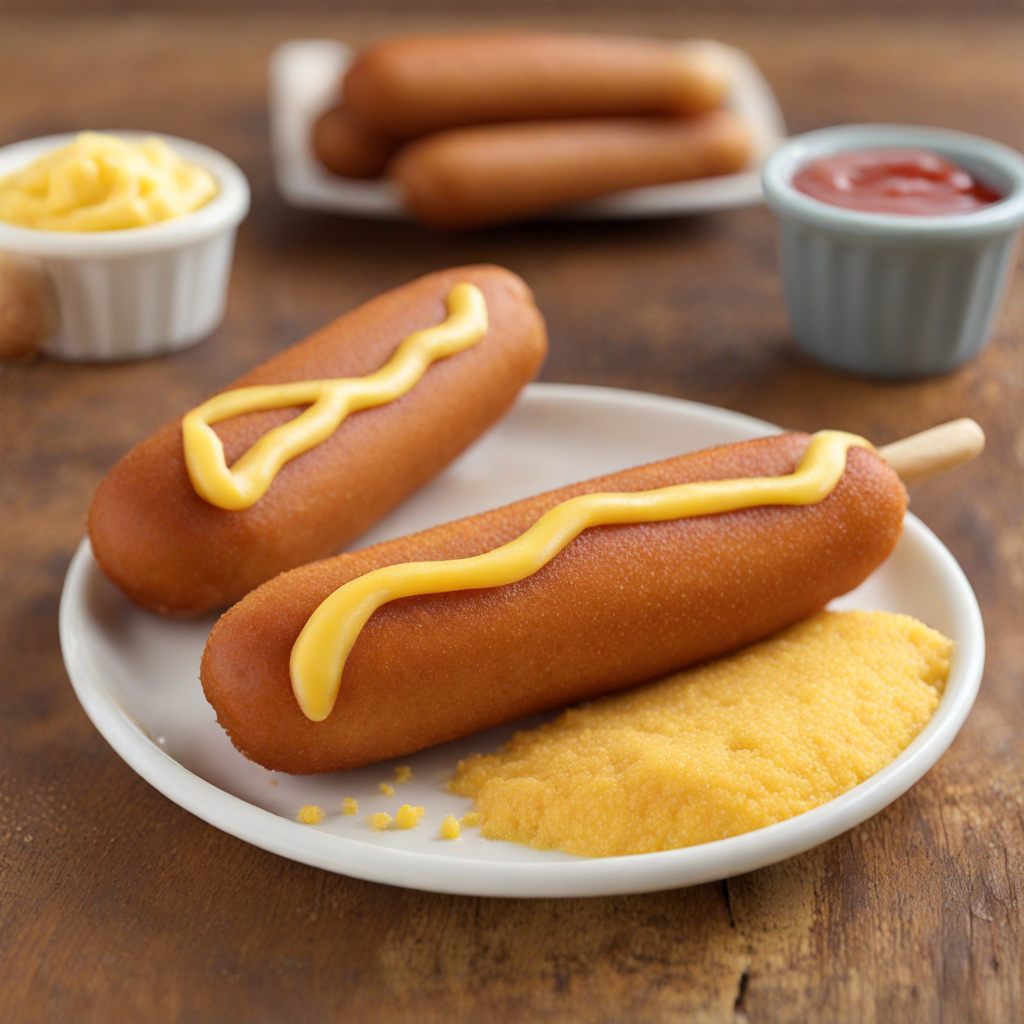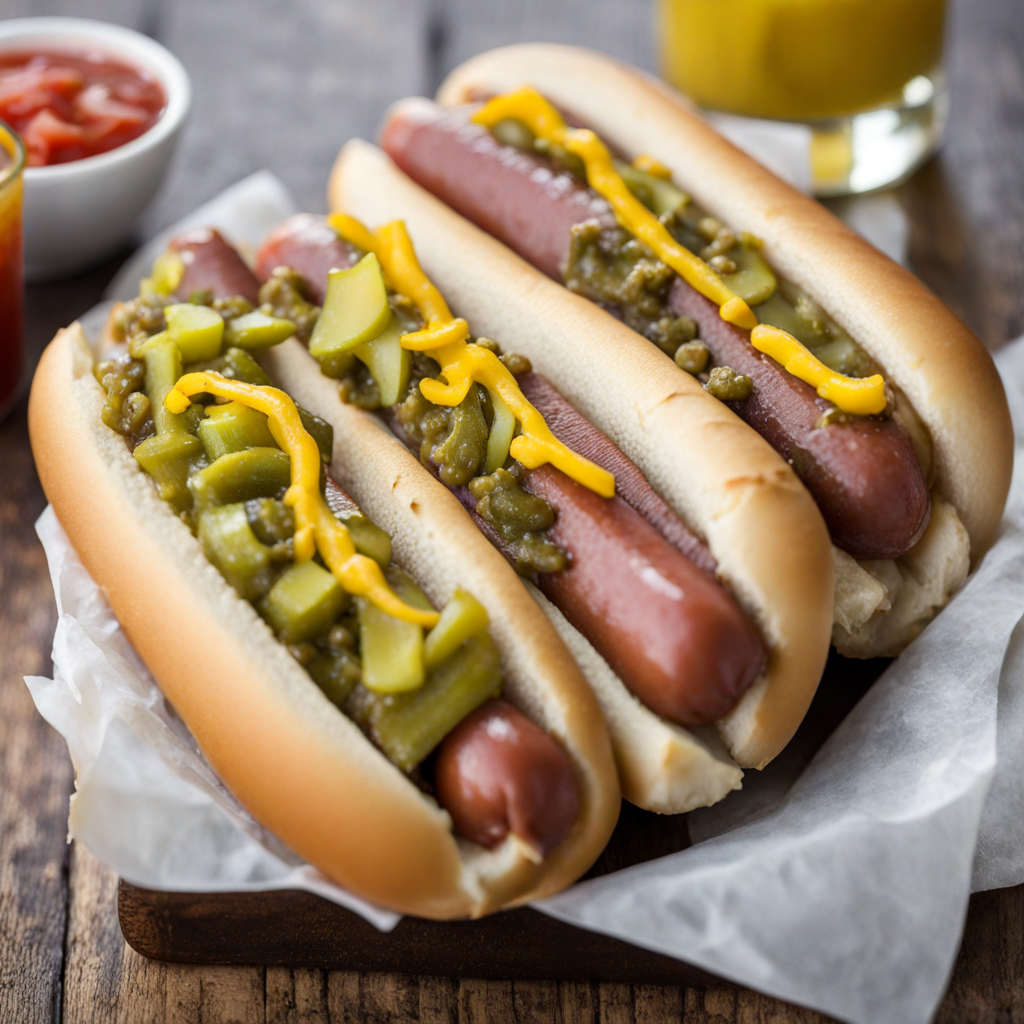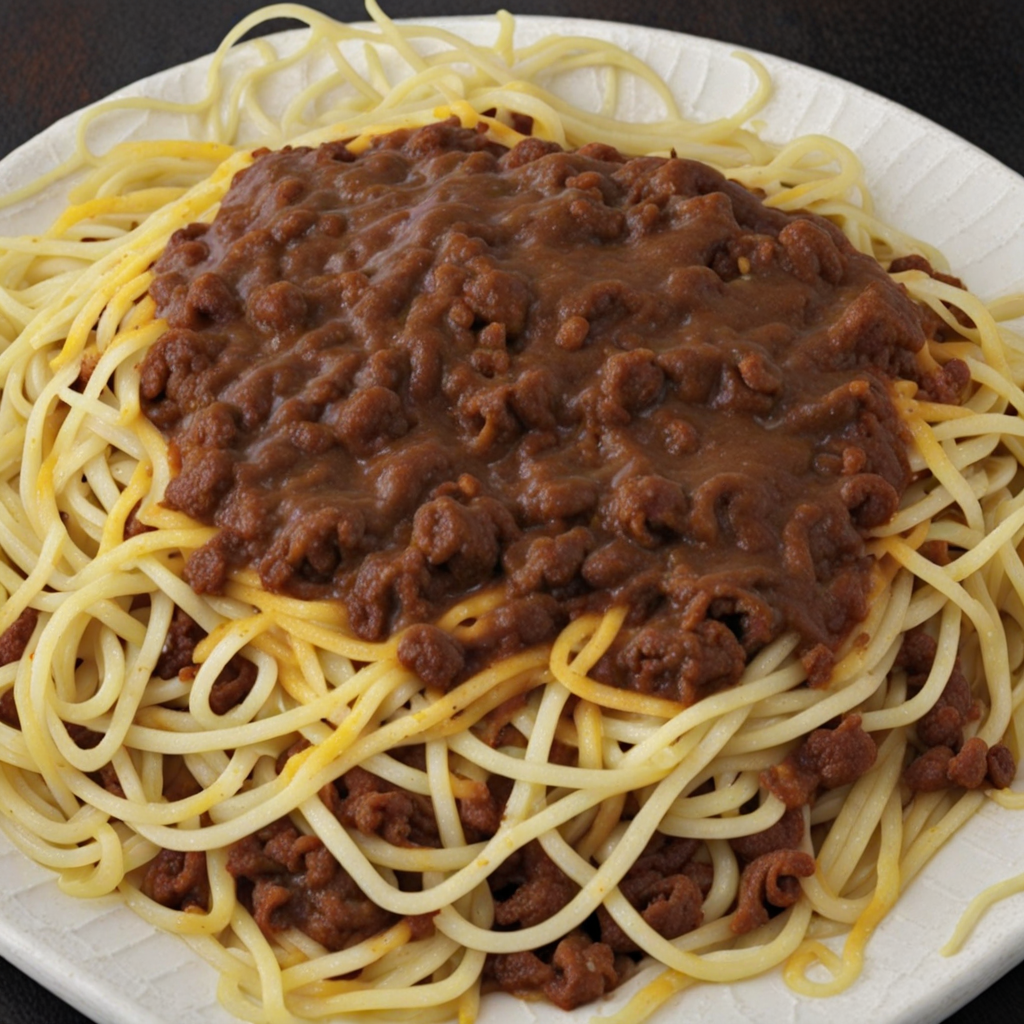Corn Dog
Corn dogs are a beloved American street food that perfectly encapsulates the fun and flavor of casual dining. At its core, a corn dog consists of a hot dog that is skewered on a stick, dipped in a thick cornmeal batter, and deep-fried to golden perfection. The batter is slightly sweet and has a delightful crunch, creating a satisfying contrast to the juicy, savory hot dog inside. Typically enjoyed at fairs, carnivals, or food trucks, corn dogs evoke a sense of nostalgia and are often paired with a side of mustard or ketchup for dipping, enhancing their flavor with a tangy kick. When you take your first bite of a corn dog, you are met with a delightful combination of textures — the crispy exterior gives way to the tender hot dog, which can be made from various meats including beef, pork, or turkey. The cornmeal batter adds a unique sweetness that complements the saltiness of the hot dog, resulting in a harmonious blend of flavors. This simple yet satisfying dish is often a crowd-pleaser, making it a popular choice for gatherings, picnics, or as a quick snack on the go. Corn dogs can also be customized in numerous ways, with variations such as cheese-filled versions or those topped with chili or jalapeños for an added kick. Some adventurous foodies even enjoy them with unique sauces and toppings, turning this classic treat into a gourmet experience. Whether you’re enjoying a traditional corn dog at a fair or trying a gourmet version at a trendy eatery, this American classic promises a deliciously fun culinary adventure.
How It Became This Dish
The Corn Dog: A Deep Dive into Its Delicious History When one thinks of quintessential American street food, the corn dog stands out as an iconic symbol. This delightful combination of a hot dog on a stick, coated in a sweet cornmeal batter and deep-fried to a golden perfection, has captured the hearts (and appetites) of many since its emergence in the early 20th century. But what lies behind the creation of the corn dog? Its origins, cultural significance, and evolution tell a fascinating story of American culinary ingenuity. #### Origins: A Culinary Convergence The precise origins of the corn dog are somewhat murky, with multiple claims to its invention. The most widely accepted narrative credits the birth of the corn dog to the 1940s, particularly at state fairs across the United States. One of the earliest known references to a corn dog appears in a 1942 advertisement for a "corny dog" from a vendor at the Texas State Fair. However, the essential elements of the corn dog—hot dogs and cornmeal batter—have roots that intertwine with a variety of cultural influences. The hot dog itself has a history that stretches back to European sausage-making traditions, with the term "hot dog" believed to have emerged in the United States in the late 19th century. The cornmeal batter, on the other hand, reflects the Southern culinary tradition, where cornmeal has long been a staple ingredient. The combination of these elements into a portable, on-a-stick meal can be seen as a reflection of the American spirit of innovation, particularly during a time when convenience and mobility became increasingly important. #### The Cultural Significance of the Corn Dog As the corn dog gained popularity, it quickly became synonymous with American fairs and festivals. The state fair experience, characterized by vibrant lights, jubilant laughter, and the intoxicating aroma of fried foods, is incomplete without the presence of corn dogs. They represent not just a food item, but an experience that encapsulates a sense of nostalgia and community. Corn dogs have become more than just a snack; they embody the spirit of American culture, particularly within the realm of leisure and celebration. They are often associated with childhood memories—families visiting fairs, friends gathering at sporting events, and summer festivals. The accessibility of corn dogs has contributed to their status as comfort food, enjoyed by people of all ages and backgrounds. The corn dog has also evolved into a cultural icon, featuring prominently in various forms of media and pop culture. From movies to television shows, the image of a corn dog often evokes a sense of Americana that resonates deeply with the public. Additionally, the corn dog has been the subject of various culinary experiments and adaptations, showcasing its versatility and ability to transcend its simple origins. #### Development Over Time The corn dog's journey from a humble fair food to a beloved American staple is a tale of evolution and innovation. By the 1950s and 1960s, corn dogs began to appear in restaurants, amusement parks, and sporting events, solidifying their status as a popular fast-food item. This period also saw the advent of frozen corn dogs, making them accessible for home preparation. Brands like Foster Farms and State Fair capitalized on this trend, offering consumers the convenience of enjoying corn dogs without the hassle of frying them from scratch. The 1970s and 1980s marked a significant turning point for the corn dog, as it began to diversify. Vendors started to experiment with different types of sausages and toppings, leading to the creation of variations such as cheese-filled corn dogs, jalapeño corn dogs, and even gourmet versions featuring artisanal sausages. This innovation catered to evolving tastes and preferences, ensuring that the corn dog remained relevant in an ever-changing food landscape. In recent years, the corn dog has experienced a renaissance of sorts, as food trucks and gourmet restaurants have embraced the concept. Chefs have taken the traditional corn dog and given it a modern twist, incorporating unique flavor profiles and high-quality ingredients. Some establishments experiment with various batters, such as spicy cornbread or even tempura, while others offer an array of dipping sauces—from classic mustard to gourmet aioli. Furthermore, the rise of social media has played a pivotal role in the corn dog's continued popularity. Platforms like Instagram and TikTok have allowed vendors and home cooks alike to showcase their creative takes on this beloved dish, sparking viral trends and inspiring a new generation of corn dog enthusiasts. Food festivals and competitions celebrating the corn dog have also emerged, creating a community of passionate fans dedicated to perfecting this iconic snack. #### The Corn Dog Today: A Global Perspective While the corn dog is inherently American, its appeal has extended beyond the borders of the United States. International adaptations of the corn dog have surfaced, with variations found in countries like South Korea, where "hotteok" or "korean corn dogs" have taken the concept to new heights. These versions often include a range of fillings, such as mozzarella cheese or sweet potato, and are sometimes coated in panko breadcrumbs for an extra crunch. Moreover, the corn dog has become a canvas for culinary creativity, as chefs worldwide experiment with flavors and ingredients unique to their cultures. In a globalized food environment, the corn dog serves as a reminder of how traditional dishes can be reinterpreted and embraced by diverse communities. #### Conclusion: A Timeless Classic The corn dog stands as a testament to the American culinary experience—a delicious, portable snack that embodies the spirit of innovation, community, and nostalgia. From its humble beginnings at state fairs to its contemporary adaptations in gourmet kitchens, the corn dog has evolved while remaining rooted in its origins. As it continues to adapt and thrive in an ever-changing food landscape, the corn dog is sure to retain its place as a favorite among food lovers for generations to come. Whether enjoyed at a fair, a sporting event, or from the comfort of home, the corn dog is more than just food; it is a cherished piece of American culture and history.
You may like
Discover local flavors from United States







